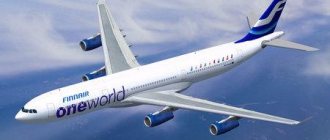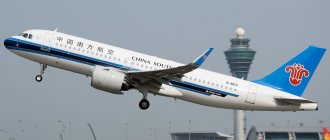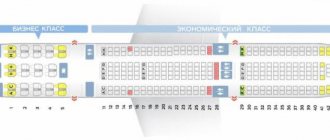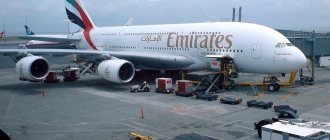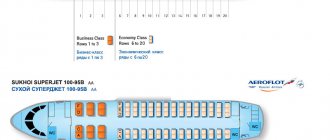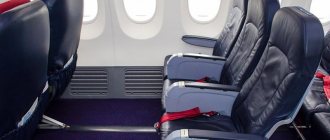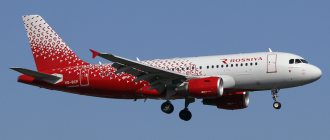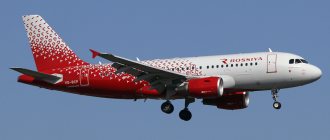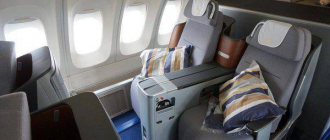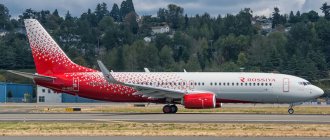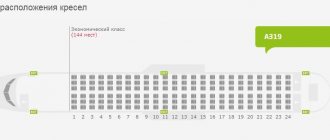| Scheme Reviews |
The Boeing 777–200 passenger aircraft (Boeing 777–200) is the first modification of the 777 series, a wide-body airliner for long-haul flights.
The Boeing 777-200 made its maiden flight on June 12, 1994, and was then transferred to United Airlines.
The ER modification has additional fuel capacity; the installed engine is designed for transatlantic routes.
A special feature of the LR modification is that it is one of the longest liners. In addition, this particular aircraft set the world record for the longest non-stop flight of a commercial airliner in 2005.
For international flights, the Boeing 777-200 and its modifications continue to be used by Air China, British Airways, Cathay Pacific Airways and other major carriers; Emirates operates Boeing 777-200LR aircraft.
The current operator of the Boeing 777-200 airliner in Russia is Nordwind Airlines.
The Aeroflot and Rossiya fleets use a more modern and longer Boeing 777 model - the 777-200.
Previously, Boeing 777-200ER aircraft were in the fleet of the airline (closed in 2015) and Orenburg Airlines (ceased to exist in March 2016).
© Hideyuki KAMON, personal. CC-BY-SA-2.0 on
Liner device
The Boeing 777 is a wide-body aircraft with two engines and a turbofan (efficient and economical) engine.
The wings of the airliner are located low relative to the body (low wing). The shape of the wing resembles an arrow (swept shape). The hull and some elements of the aircraft (the floor in the cabin, the rudder in the cockpit, and others) consist of almost 10% of special alloys and materials, which affects both the strength and the overall weight of the aircraft. Boeing landing gear consists of 6 wheels.
The aircraft is fully equipped with a digital remote control system on a par with conventional steering wheels. The Boeing 777 was the first to use innovative technologies for convenience and comfort: a video screen mounted in the back of the seat, an electronic flight log. For the convenience of passengers, the size of the shelves has been increased.
For a comfortable long flight for the crew on the 777, a rest room with comfortable chairs and sleeping places was added above the head cabin.
The developers also did not ignore the aesthetic component: smooth lines of the interior, diffused light, large windows.
Exploitation
The Boeing 777 was developed taking into account the wishes of carrier companies and passengers. Thanks to this, the airliner takes into account most of the details that make up a comfortable flight.
Advantages
A significant advantage of aircraft of this line is the smoothness of takeoff and landing. Improved sound insulation significantly reduces engine noise.
The wide luggage racks can accommodate even large bags. To entertain passengers during long flights, multimedia systems are built into the backs of the seats.
Flaws
When ordering aircraft, airlines themselves choose the cabin layout. Some airlines, wanting to make more profit, install too many seats. The result of this approach is crowding and inconvenience for passengers, especially in economy class.
Main modifications of the aircraft and their features
Two indicators for comparison - aircraft length and flight range - allow us to distinguish several models in the Boeing 777 series. The Boeing 777-200 is considered the reference model, and the 777-300 is its modified extended version, which can accommodate up to 550 air passengers.
The difference between the 777-200 types lies in the flight duration parameters. The very first version of the 777-200 covered distances of more than 8 thousand km and was intended for domestic transportation in the United States. In 1995, work began on its modification. In simple terms, we needed an aircraft capable of even longer flights.
Boeing 777-200ER
The additional letters ER mean “extended range” - increased range, the 777-200 flies at a distance of 12 to 14 thousand km. It differs from the original version in that the aircraft's fuel capacity and take-off weight have been increased. The 777-200ER is designed for international flights, flights across the Atlantic. This model of the airliner has become the most popular passenger aircraft.
Boeing 777-200LR
The additional letters LR mean “longer range”. The aircraft is capable of flights of more than 14 thousand km, and can “connect two opposite points” on the globe (Dallas - Tokyo, Singapore - Los Angeles). Boeing set a famous record for the longest flight distance (without landing) among passenger airliners, the 777-200LR flew more than 17 thousand km (17370 km).
It differs from previous versions by even greater take-off weight and three additional fuel tanks. The appearance is also slightly modified, with slightly more raked wings, reinforced landing gear and a powerful airframe.
Comparative characteristics of Boeing 777-200 models
History of creation
In the 1970s, the constant growth in the popularity of passenger air travel led to the fact that existing aircraft at that time could no longer meet the increased demand. To update the line of airliners, Boeing began to develop new models - the twin-engine 757 and 767, as well as the three-engine 777.
The new airliners would compete with products from Airbus, McDonnell Douglas and Lockheed. However, later the 777 project had to be abandoned due to limited resources and low demand.
The situation changed in the 1980s, when wide-body aircraft became in demand.
At first it was planned to modernize the Boeing 767, but the presented project did not satisfy the airline.
Carriers needed an aircraft similar in configuration to the Boeing 747, but designed to fly relatively short distances. The use of three engines was already redundant, and the new car received two engines.
For the project of the revived Boeing 777, the company took a non-standard approach. The development of the aircraft was carried out in constant cooperation with several major airlines. They conducted surveys among passengers, and then combined their results with their requirements for the new liner. Thanks to this approach, it was possible to create an aircraft that is better suited to end users than others.
Development of the Boeing 777 began in 1990. Five years later, the first copy appeared on commercial airlines.
777-200 cabin layout
The interior layout depends on two parameters:
- configuration (position) and number of seats in the cabin
- number of classes
The seats are arranged in rows, the number of which varies depending on the cabin configuration, from 43 to 62. The number of seats in a row also varies from 4 to 10. The fewer seats in a row, the more prestigious the class. The number of seats in the cabin ranges from 306 to 550 The arrangement of seats, kitchen and toilets is very diverse, and the layout of the cabin itself makes it possible, if necessary (or at will), to rearrange passenger seats and other elements.
The standard division into classes throughout the world involves 3 levels:
- first
- business
- economy
But many airlines have their own categories. For example:
- imperial, as a subspecies (or replacement) of the first,
- premium or premium, somewhere it belongs to business class, and somewhere to economy class,
- tourist, as a subtype of economy class.
As a rule, 777-200 aircraft have cabins with 2 or 3 classes, but in some cases there are 1 (440 seats) and 4.
Boeing 777-200 with 2 cabin classes
These are the classes:
- business
- economy
The level of high comfort - business class - is located in the front part of the aircraft. The chairs at this level are at a sufficient distance from each other, this allows you to recline your back, stretch your legs or place them on a special stand. On an aircraft with 306, 314 or 396 seats, business class is small, with only 6 to 10 seats in a 2-2-2 or 2-3-2 configuration, arranged either in rows or in a checkerboard pattern.
Economy class takes up most of the cabin. The seats are arranged differently depending on the aircraft: 2-5-2, 3-4-3 and 3-3-3. The distance between the seats is significantly smaller than in business class, which is especially inconvenient for tall people. The small distance between the seats does not allow you to recline the back, but only slightly tilt it (45 degrees).
Toilets are located in the central and aft sections of the cabin.
Boeing 777-200 with 3 cabin classes
These are the classes:
- first (or luxury class, or imperial)
- Business Class
- economy
Sometimes there is a configuration of three classes: business, economy and tourist. In terms of quantity it comes out to 3, but in fact this is an aircraft with two comfort classes: business and economy.
In the bow of the aircraft there is the best elite class - first or premium. Number of seats from 6 to 16, in 1-2-1 or 2-2-2 configurations. The chairs are more like mini-sofas, large, comfortable with reclining backs. This class has a separate toilet and its own kitchen.
Business class is more spacious (up to 42 seats) compared to the previous layout, but, in general, it is no different in terms of comfort. This classroom also has a separate toilet and kitchen.
In the center and tail of the plane is the remaining economy class, with an average of 180 seats. All characteristics of economy class are the same, regardless of the interior modification.
Boeing 777-200 with 4 cabin classes
These are the classes:
- first
- Business Class
- economy
- tourist
A distinctive feature of this form of layout is the division of economy class into two types: economy class itself and tourist class. They are no different in terms of seat layout or comfort level. The only thing: economy class is located in the center, and tourist class is at the rear of the plane.
The rows in the aircraft cabin are designated by Arabic numerals (1, 2, 3 ... 43), and the seats are designated by Latin letters (A, B, C ... K, L)
Description of seats by block of rows
The entire Boeing 777-300/ER aircraft interior is designed for maximum passenger comfort. But, as on any other ship, there are good seats and worse ones (especially for passengers with children). This applies not only to economy class; such gradation also exists in other compartments.
Business Class
Business class in the 77w model is an environment of increased comfort. Comfortable leather chairs occupy 5 rows and are arranged in a 3x2 pattern (with 2 aisles).
Note! The seats are located one after another at a distance of 150 cm, which allows the chairs to be turned into beds (even in the last row) without causing discomfort to neighbors. .
All the seats in the compartment can be called quite comfortable, but there are still some undesirable places: the 1st row is located not far from the toilet. This will not cause any aesthetic inconvenience in this class of service, but the walking of people may interfere with rest. Although this particular row is preferable for passengers with small children, since there are devices for attaching the cradle.
Comfort class
This compartment is more convenient for passengers compared to economy class, but is somewhat inferior to the business option. The seating arrangement here is as follows: 6 rows (from 11 to 16) contain 4 seats in the center and 2 seats at each side.
Note! The distance between the seats is optimal so that you can travel reclining. But in this compartment, the seat backs do not recline, but the seats move forward, which is convenient for rear passengers.
The 11th row is available for passengers with babies, as there is room to hang a cradle. But for others, such a neighborhood may not be entirely desirable. It will be difficult to relax on this row also because of the close-located partition (you cannot fully stretch your legs).
In front of the same row, on the left side, there is a toilet, which also cannot be called a pleasant neighborhood. The 16th row is also inconvenient, since there is a thin partition behind the seats, through which noise can be heard from the economy class cabin.
Economy class
The largest compartment is economic. It is divided into sections - in the middle, each row contains 4 seats, in the side rows - 3 (with some exceptions, they are visible in the above diagram).
First rows of economy class
Most of the seats on the plane are standard, with an average degree of comfort. But here we can highlight some features of a number of passenger seats - they are shown in the table below (the interior layout of the Boeing 777-300/er is taken as a basis).
Features of some seats in economy class
| Rows | Places | Peculiarities |
| 17 | A, C, H, K | There are 2 chairs on each side, which is convenient for traveling as a couple. |
| D, E, F, G | The absence of seats in front gives free legroom. The carrycot attachment allows these seats to be used when traveling with babies. The disadvantage is the lack of an entertainment monitor, passengers are forced to look at the wall. | |
| 18 | C, H | There are no seats in the previous row in front of these seats, which provides sufficient legroom. |
| 20 | – | The absence of windows will suit those who like to sleep in flight, but will be inconvenient for those who prefer to look out the window. |
| 24, 38 | – | The rows are quite comfortable, as there are free seats in front of the seats due to the presence of emergency exits. The disadvantage is that there is no place to place hand luggage, and pregnant women, disabled people, passengers with children and animals are not allowed to fly in these seats. |
| C, H | The toilets and kitchens located nearby cause inconvenience - there are constant smells, and the periodic movement of people interferes. | |
| 23, 36, 37, 50, 51 | Aisle Seats | Due to the close location of the toilets, the constant movement of passengers interferes, and sometimes queues arise. |
| 47-51 | – | There are 2 chairs on each side, which already provides some convenience. Despite the fact that turbulence is more noticeable here, these rows are considered the safest. The disadvantage is that due to the narrowness of the tail of the aircraft, the distance between the seats in these rows is tighter. |
Having studied the layout of the best seats in the Boeing 777-300/ER cabin and found out some of the features, it will be easier to book tickets for this Aeroflot aircraft for a long-distance comfortable flight.
If you are not lucky enough to get the highest priority seats on the plane, do not despair. Most seats can be quite comfortable if they are located in the middle of the cabin and not adjacent to the aisles. The remoteness of the windows can even be a plus for those who are afraid of flying on airplanes.
Important! When traveling with small children, you don’t have to take into account the proximity of toilets. Here the priority will be the chairs next to the places for attaching the bassinets
Pros and cons of seating arrangement, choosing a seat when purchasing a ticket
When choosing a seat, most passengers are guided by criteria such as:
- class and level of comfort, and, consequently, the cost of the ticket
- row, its proximity or distance to partitions and toilet
- location in a row (in the center, near the aisle, closer to the window, etc.)
The most comfortable seats, but also the most expensive, are first and business class seats. The only downside of these seats is their cost. Accordingly, the more advantages according to the listed criteria, the more comfortable the flight. And vice versa.
At the very beginning of economy class, immediately after business class, there are partitions; they are always indicated on the layout diagram. Here, as a rule, there are toilets. And both factors make the first row of economy seats extremely uncomfortable.
Economy class is divided either into two parts (center and tail) or into tourist class. Between them is an emergency exit, or a partition, or a toilet, which in each case brings its own inconvenience to the last row of the central part of the aircraft.
But the first row of the tail section, on the contrary, is convenient because there is additional space. On long flights, this can be a deciding factor, regardless of whether there is a toilet nearby.
The last rows at the very back of the plane are characterized in the same way as the central ones: there is an inconvenient partition, which makes it difficult to recline the seat, a toilet and a constant queue for it. The only plus, especially for those who are afraid of flying, is the statistical fact of survival in plane crashes (more than 60% of survivors sat here).
The remaining places are considered standard in terms of convenience and comfort.
Specifications
Today, the Boeing 777-300/er is one of the best-selling aircraft in the world due to its technical characteristics. The 2-motor design used in the car made it possible to reduce operating costs by 9% and fuel costs by 20%. The main parameters of this model are shown in the table below.
Technical features of the Boeing 777-300/ER
| Indicators | Unit change | Options |
| Aircraft length | m | 73,9 |
| Aircraft height | m | 18,7 |
| Fuselage width | m | 6,19 |
| Wingspan | m | 64,8 |
| Cabin capacity | classes/places | 3/402 |
| Mach takeoff weight | tn | 351,5 |
| Max speed (cruising) | km/h | 945 (905) |
| Mach flight range | thousand km | 14,69 |
| Ceiling (echelon) height | thousand km | 13,14 |
This model also differs in its interior. The largest windows were used on these planes. The configuration of the cabin makes it possible to move around freely. And since 2003, the 77w model has introduced rest areas for crew on long-haul flights.

